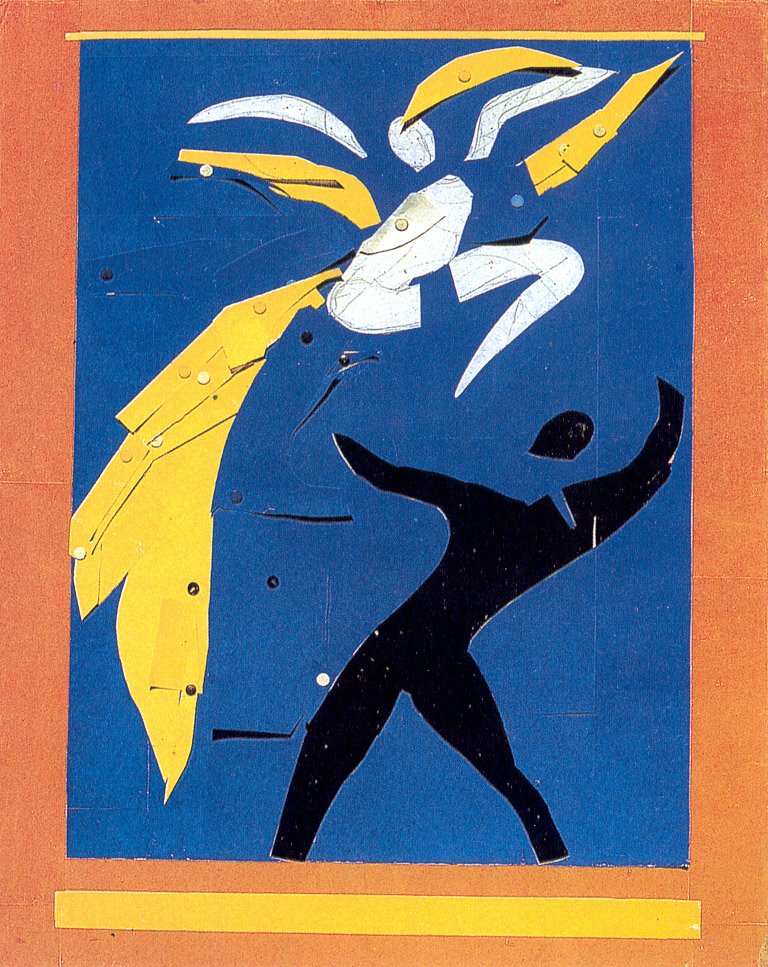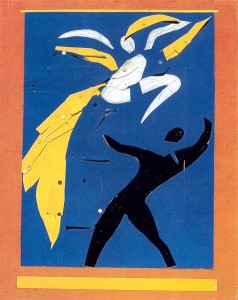Visual Culture Seminar
February 23, 2015
The Strana Forandola By Henri Matisse
Formal Analysis
Henri Matisse was a french a artist that was mainly known for his use of color, in the final stage of his life he adopted a technique known as the Cut Outs where he used gouache paint to create compositions of color and form. There is no doubt that in The Strana Forandola (1938 gouache and cut out paper 61 x 61 cm, private collection) one of the “Cut-out” pieces Matisse represents the rhythm and balance of dance. Through color, texture, and composition you can see how this two concepts that play so directly to the essence of dance appear in the piece.
Texture, the feel, appearance, or consistency of a surface or a substance is one of the first things you notice when you look at this piece. Just a simple glance will do to make the viewer notice that it is one of a kind and well thought out. The lightly lifted paper held together by simple and small pins gives a unique texture that most painters would never even consider. Even though the technique might look easily done it achieve to extract the flatness Matisse disliked in many of his other works. Texture holds a direct effect on the rhythm of the piece since it takes away the flatness and makes it look like the dancers are truly in motion. Each lifted paper helps the viewer grip the fastness and glide that a dance possesses and the balance that is needed since too much texture might have taken away from the main pint of simplicity used in telling this story.
Color, what Matisse was mainly known for is an essential part to understanding this piece. What today might be called something like “color-block” meaning that each form had one color and one color only makes the captivating piece look so balanced to the viewer. The two main figures have plain black and white colors that contrast with the deep blue color making them clearly the main subject in the piece. Surrounding the blue and the main figures of the man and the women dancing are vibrant pieces if yellow that shows how rhythm plays a huge part in the dance process. To conclude there is a bright orange frame that holds the painting together making it look complete.
Lastly composition, or the way the whole painting is made up is the perfect example of balance and rhythm at the same time. Matisse worked on what he called a “Composition Card Game” the way this simple piece is set up has gives makes the piece look finished and well-rounded. How the main subjects are off-centre and with captivating cutout pieces around it makes The Strana Forandola succeed at its composition. The bright orange frame that surrounds it just like it helps in color it most definitely helps in composition it is what holds the main subjects together and what makes the pose the two main subjects are engaging in look like just one step to a larger more rhythmic dance.
There is no need to explain that The Strana Forandola By Henri Matisse excels at showing the rhythm of composition, texture and color all of them are shown perfectly and can be seen by looking at the piece for a small period of time or for a long one, the piece clearly is a straightforward one that tells a complicated story and like all of his other pieces Matisse clearly found the perfect combination of simplicity and complexity.


